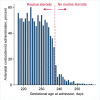Antenatal corticosteroid administration and early school age child development: A regression discontinuity study in British Columbia, Canada
- PMID: 33284805
- PMCID: PMC7721186
- DOI: 10.1371/journal.pmed.1003435
Antenatal corticosteroid administration and early school age child development: A regression discontinuity study in British Columbia, Canada
Abstract
Background: There are growing concerns that antenatal corticosteroid administration may harm children's neurodevelopment. We investigated the safety of antenatal corticosteroid administration practices for children's overall developmental health (skills and behaviors) at early school age.
Methods and findings: We linked population health and education databases from British Columbia (BC), Canada to identify a cohort of births admitted to hospital between 31 weeks, 0 days gestation (31+0 weeks), and 36+6 weeks, 2000 to 2013, with routine early school age child development testing. We used a regression discontinuity design to compare outcomes of infants admitted just before and just after the clinical threshold for corticosteroid administration of 34+0 weeks. We estimated the median difference in the overall Early Development Instrument (EDI) score and EDI subdomain scores, as well as risk differences (RDs) for special needs designation and developmental vulnerability (<10th percentile on 2 or more subdomains). The cohort included 5,562 births admitted between 31+0 and 36+6 weeks, with a median EDI score of 40/50. We found no evidence that antenatal corticosteroid administration practices were linked with altered child development at early school age: median EDI score difference of -0.5 [95% CI: -2.2 to 1.7] (p = 0.65), RD per 100 births for special needs designation -0.5 [-4.2 to 3.1] (p = 0.96) and for developmental vulnerability of 3.9 [95% CI:-2.2 to 10.0] (p = 0.24). A limitation of our study is that the regression discontinuity design estimates the effect of antenatal corticosteroid administration at the gestational age of the discontinuity, 34 + 0 weeks, so our results may become less generalisable as gestational age moves further away from this point.
Conclusions: Our study did not find that that antenatal corticosteroid administration practices were associated with child development at early school age. Our findings may be useful for supporting clinical counseling about antenatal corticosteroids administration at late preterm gestation, when the balance of harms and benefits is less clear.
Conflict of interest statement
The authors have declared that no competing interests exist.
Figures




Similar articles
-
Antenatal corticosteroids and newborn respiratory outcomes in twins: A regression discontinuity study.BJOG. 2024 Jul;131(8):1064-1071. doi: 10.1111/1471-0528.17754. Epub 2024 Jan 14. BJOG. 2024. PMID: 38221505
-
The impact of the Antenatal Late Preterm Steroids trial on the administration of antenatal corticosteroids.Am J Obstet Gynecol. 2022 Aug;227(2):280.e1-280.e15. doi: 10.1016/j.ajog.2022.03.037. Epub 2022 Mar 24. Am J Obstet Gynecol. 2022. PMID: 35341727
-
Antenatal corticosteroid administration and attention-deficit/hyperactivity disorder in childhood: a regression discontinuity study.CMAJ. 2022 Feb 22;194(7):E235-E241. doi: 10.1503/cmaj.211491. CMAJ. 2022. PMID: 35193860 Free PMC article.
-
[Prevention of preterm birth complications by antenatal corticosteroid administration].J Gynecol Obstet Biol Reprod (Paris). 2016 Dec;45(10):1399-1417. doi: 10.1016/j.jgyn.2016.09.008. Epub 2016 Oct 21. J Gynecol Obstet Biol Reprod (Paris). 2016. PMID: 27776846 Review. French.
-
Antenatal Corticosteroids for Fetal Lung Maturity - Too Much of a Good Thing?Curr Pharm Des. 2019;25(5):593-600. doi: 10.2174/1381612825666190326143814. Curr Pharm Des. 2019. PMID: 30914016 Review.
Cited by
-
Regression discontinuity design to evaluate the effect of statins on myocardial infarction in electronic health records.Eur J Epidemiol. 2023 Apr;38(4):393-402. doi: 10.1007/s10654-023-00982-w. Epub 2023 Mar 20. Eur J Epidemiol. 2023. PMID: 36935439
-
Counterpoint: The value of benchmarking in observational studies of the longer term safety of antenatal corticosteroids.Paediatr Perinat Epidemiol. 2023 Jan;37(1):15-18. doi: 10.1111/ppe.12937. Epub 2022 Dec 8. Paediatr Perinat Epidemiol. 2023. PMID: 36482791 Free PMC article. No abstract available.
-
Glucocorticoid exposure-induced alterations in epigenetic age from human preterm infants and human lung fibroblasts and hippocampal neuronal cells.Clin Epigenetics. 2025 Feb 20;17(1):29. doi: 10.1186/s13148-025-01837-9. Clin Epigenetics. 2025. PMID: 39980002 Free PMC article.
-
Evaluation of Long-term Outcomes Associated With Preterm Exposure to Antenatal Corticosteroids: A Systematic Review and Meta-analysis.JAMA Pediatr. 2022 Jun 1;176(6):e220483. doi: 10.1001/jamapediatrics.2022.0483. Epub 2022 Jun 6. JAMA Pediatr. 2022. PMID: 35404395 Free PMC article.
-
Perinatal Treatment with Corticosteroids and Its Relation with Neurodevelopment in Premature Newborns: A Systematic Review of the Literature.Turk Arch Pediatr. 2025 Jul 1;60(4):355-361. doi: 10.5152/TurkArchPediatr.2025.24299. Turk Arch Pediatr. 2025. PMID: 40637325 Free PMC article.
References
-
- Royal College of Obstetricians and Gynaecologists. Antenatal Corticosteroids to Reduce Neonatal Morbidity and Mortality. London, UK, 2010.
-
- National Institutes of Health. Effect of corticosteroids for fetal maturation on perinatal outcomes. NIH Consens Statement. 1994; 12(2): 1–24. - PubMed
-
- National Institute for Health and Care Excellence. Preterm Labour and Birth. NICE Guideline. 2019;25. - PubMed
Publication types
MeSH terms
Substances
Grants and funding
LinkOut - more resources
Full Text Sources
Medical
Miscellaneous

